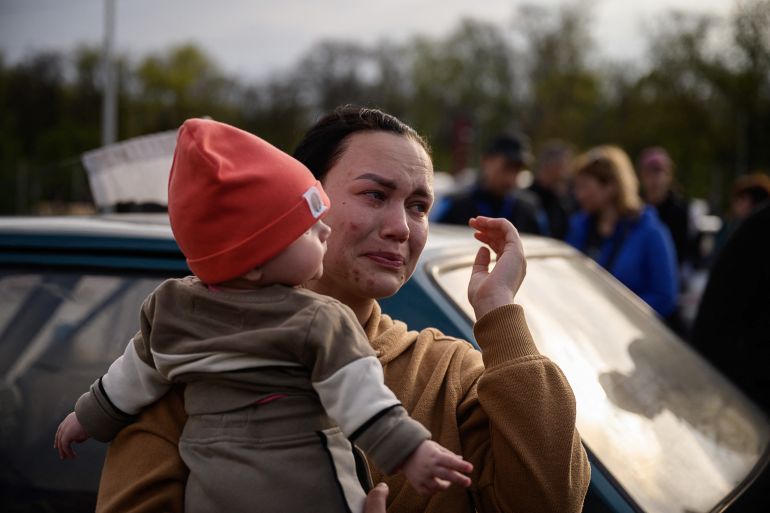Civilian evacuees from Azovstal plant reach Ukrainian-held city
Dozens of evacuees from Mariupol arrive in Zaporizhzhia as Russia resumes attacks on the besieged Azovstal steel plant.

The first convoy of civilians to escape from a steel plant in Russian-occupied Mariupol has reached the relative safety of Ukraine-controlled Zaporizhzhia, as Russian forces launched a new assault on the site.
The United Nations confirmed 127 civilians evacuated from the besieged plant and a nearby town arrived in the Ukrainian-controlled city, some 230km (140 miles) northwest of Mariupol, on Tuesday.
Keep reading
list of 3 itemsTop US legislator Pelosi meets Poland’s Duda after Ukraine trip
Russian theatre drops directors who spoke against Ukraine war
Osnat Lubrani, the UN humanitarian coordinator for Ukraine, said 101 civilians left the steelworks as part of a five-day operation coordinated by the UN and the International Committee of the Red Cross that began on April 29.
They “could finally leave the bunkers below the Azovstal steelworks and see the daylight after two months”, she said in a statement.
Another 58 people joined the convoy in Manhush, a town on the outskirts of Mariupol.
I'm relieved to confirm that the safe passage operation from Mariupol has been successful.
The people I travelled with told me heartbreaking stories of the hell they went through.I'm thinking about the people who remain trapped. We will do all we can to assist them. pic.twitter.com/mEqTTKZKA8
— Osnat Lubrani (@OsnatLubrani) May 3, 2022
Some of the evacuees opted to be dropped off before arriving in government-controlled territory, Lubriani said. The Russian military also said some evacuees had chosen to stay in separatist areas.
In Zaporizhzhia, dozens of evacuees including young children and pensioners laden with bags clambered off buses that pulled into the car park of a shopping centre.
“I can’t believe I made it, we just want rest,” said Alina Kozitskaya, who spent weeks sheltering in a basement with her bags packed waiting for a chance to escape.
Hospitals in the city were stocked up before the arrival of the convoy, according to Dorit Nizan, the World Health Organization’s incident manager for Ukraine.
“We are ready for … burns, fractures and wounds, as well as diarrhoea, respiratory infections. We are also ready to see if there are pregnant women, children with malnutrition. We are all here and the health system is well prepared,” Nizan said.
Al Jazeera’s Hoda Abdel-Hamid, reporting from Zaporizhzhia, said five buses carrying evacuees from Mariupol had arrived in the city.
“It took three days to get them from there to here, on a route that would normally take about three hours [to complete],” she said.
“The UN said that at every point, there had to be negotiations about what was going on.”
Before arriving in Zaporizhzhia, the evacuees were first taken to a temporary accommodation centre in the village of Bezimenne, which is under the control of the self-proclaimed Donetsk People’s Republic.
Meanwhile, the Russian military said it had resumed strikes on the Azovstal steel plant after a ceasefire broke down.
Russian Defence Ministry spokesman Vadim Astafyev claimed Ukrainian fighters at the plant used the ceasefire that allowed civilians to flee to take up new positions.
They “came out of the basements, took up firing positions on the territory and in the buildings of the plant”, he said. Russian troops along with the Moscow-backed separatist forces used “artillery and aircraft … to destroy these firing positions”.
Mariupol patrol police chief Mykhailo Vershinin told Ukrainian television that the Russian military had “started to storm the plant in several places”.
The deputy commander of the Azov Regiment, who is inside the Azovstal steel plant, was quoted by Ukrainian media confirming the account.
Denys Shlega, a commander of a brigade of Ukraine’s National Guard who is also at the steel plant, said, “The enemy is trying to storm the Azovstal plant with significant forces using armoured vehicles.”
The sprawling Soviet-era steelworks is the last holdout of Ukrainian resistance in a city that is otherwise controlled by Moscow’s forces and key to their campaign in Ukraine’s east.
A Russian siege has trapped civilians with little access to food, water and electricity, as Moscow’s forces pounded the city to rubble.
Mariupol Mayor Vadym Boychenko estimated more than 200 civilians remained holed up in the Azovstal steel plant, as well as about 100,000 civilians in the city of Mariupol.
Mariupol Deputy Mayor Sergei Orlov told the BBC that high-level negotiations were under way among Ukraine, Russia and international organisations on evacuating more people.
The capture of the port city would deprive Ukraine of a vital commercial hub and allow Russia to establish a land corridor to the Crimean Peninsula, which it seized from Ukraine in 2014.
Michael Carpenter, US ambassador to the Organization for Security and Cooperation in Europe, said on Monday that Moscow is planning to annex much of eastern Ukraine and recognise the southern city of Kherson as an independent republic.